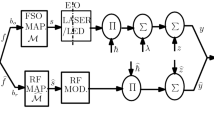Abstract
Wireless communication has achieved lot of attention and the demand is continually increasing day by day. Radio frequency (RF) is highly attracted by various wireless communication applications. The RF spectrum is already very crowded and the rapid increase in the use of wireless services has led the problems of RF spectrum exhaustion and eventually RF spectrum deficit. Free space optical (FSO) communication is a viable technology with a plenty of bandwidth, license-free spectrum and interference free link. On the other hand, FSO channel is severely corrupted by atmospheric turbulence and non-predictive weather scenarios. We suggest a hybrid FSO/RF communication system in our previous research, which can mitigate the issues of the individual links. In this research, we investigate the performance of the proposed adaptive system for reliable data transmission. We develop modulation and power adaptive schemes for maximizing the mutual information. The proposed adaptive system is compared with non-adaptive system, which gives 2.75 dB gain for the joint power and 0.75 dB gain for the separate power constraint.









Similar content being viewed by others
References
Alouini, M., Borgsmiller, S., & Steffes, P. (1997). Channel characterization and modelling for Ka-band very small aperture terminals. Proceedings of the IEEE, 85(6), 981–997.
Gagliardi, R. M., & Karp, S. (2006). Optical communications (2nd ed.). New York: Wiley.
Khan, M., & Jamil, M. (2014). Maximizing throughput of free space communication systems using puncturing technique. Arabian Journal for Science and Engineering, 39(12), 8925–8933.
Khan, M. N. (2014). Importance of noise models in FSO communications. EURASIP Journal on Wireless Communications and Networking, 2014(102), 1–10.
Ghassemlooy, Z., Joaquin, P., & Erich, L. (2013). On the performance of FSO communications links under sandstorm conditions. In 12th international conference on telecommunication-ConTEL13, Zagreb, Retrieved June 1–6, 2013.
Khan, M. N., & Cowley, W. G. (2012). Link adaptation of FAHOR communication system. In Communications theory workshop (AusCTW), 2012 Australian (pp. 142–147). Wellington.
Hariq, S., Odabasioglu, N., & Uysal, M. (2014). An adaptive modulation scheme for coded free-space optical systems. In 19th European conference on networks and optical communications (NOC) (pp. 132–135), Milano.
Salah, M., Cowley, W., & Nguyen, K. (2014). Adaptive transmission schemes for free-space optical channel. In 2014 8th international conference on signal processing and communication systems (ICSPCS), Gold Coast, QLD. Retrieved December 1–7, 2014.
Tapse, H., & Borah, D. (2009). Hybrid optical/RF channels: characterization and performance study using low density parity check codes. IEEE Transactions on Communications, 57(11), 3288–3297.
Khan, M. N., & Cowley, W. G. (2011). Signal dependent Gaussian noise model for FSO communications. In Communications theory workshop (AusCTW) (pp. 142–147), Melbourn.
Makki, B., Svensson, T., Eriksson, T., & Alouini, M. S. (2016). On the performance of RF-FSO links with and without hybrid ARQ. IEEE Transactions on Wireless Communications, PP(99), 1–16.
Tang, Y., Brandt-Pearce, M., & Wilson, S. G. (2012). Link adaptation for throughput optimization of parallel channels with application to hybrid FSO/RF systems. IEEE Transactions on Communications, 60(9), 2723–2732.
Rakia, T., Yang, H.-C., Alouini, M.-S., & Gebali, F. (2015). Outage analysis of practical FSO/RF hybrid system with adaptive combining. IEEE Communications Letters, 19(8), 1366–1369.
Letzepis, N., Nguyen, K. D., Guilln i Fbregas, A., & Cowley, W. G. (2010). Hybrid free-space optical and radio-frequency communications: Outage analysis. IEEE international symposium on information theory (pp. 2048–2052). Austin, TX.
Webb, P. P., McIntyre, R. J., & Conradi, J. (1974). Properties of avalanche photodiodes. RCA Review, 35(1), 234–278.
Andrews, L., & Phillips, R. (2005). Laser beam propagation through random media (2nd ed.). Bellingham: SPIE Press.
Gallager, R. (1968). Information theory and reliable communication. New York: Wiley.
Khan, M. N., & Cowley, W. G. (2011). Signal dependent Gaussian noise model for FSO communications. Australian communications theory workshop (AusCTW) (pp. 142–147).
Acknowledgments
The author would like to thank Prof. Bill Cowley and Khoa D. Nyugen for their suggestion and useful discussion during the whole journey of this research work.
Author information
Authors and Affiliations
Corresponding author
Rights and permissions
About this article
Cite this article
Khan, M.N., Jamil, M. Adaptive hybrid free space optical/radio frequency communication system. Telecommun Syst 65, 117–126 (2017). https://doi.org/10.1007/s11235-016-0217-8
Published:
Issue Date:
DOI: https://doi.org/10.1007/s11235-016-0217-8




